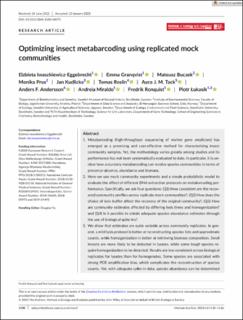| dc.contributor.author | Iwaszkiewicz-Eggebrecht, Elzbieta | |
| dc.contributor.author | Granqvist, Emma | |
| dc.contributor.author | Buczek, Mateusz | |
| dc.contributor.author | Prus, Monika | |
| dc.contributor.author | Kudlicka, Jan | |
| dc.contributor.author | Roslin, Tomas | |
| dc.contributor.author | Tack, Ayco J. M. | |
| dc.contributor.author | Andersson, Anders F. | |
| dc.contributor.author | Miraldo, Andreia | |
| dc.contributor.author | Ronquist, Fredrik | |
| dc.contributor.author | Łukasik, Piotr | |
| dc.date.accessioned | 2023-07-18T07:18:20Z | |
| dc.date.available | 2023-07-18T07:18:20Z | |
| dc.date.created | 2023-05-08T15:05:56Z | |
| dc.date.issued | 2023 | |
| dc.identifier.citation | Methods in Ecology and Evolution. 2023, 14 (4), 1130-1146. | en_US |
| dc.identifier.issn | 2041-210X | |
| dc.identifier.uri | https://hdl.handle.net/11250/3079669 | |
| dc.description.abstract | Metabarcoding (high-throughput sequencing of marker gene amplicons) has emerged as a promising and cost-effective method for characterizing insect community samples. Yet, the methodology varies greatly among studies and its performance has not been systematically evaluated to date. In particular, it is unclear how accurately metabarcoding can resolve species communities in terms of presence-absence, abundance and biomass. Here we use mock community experiments and a simple probabilistic model to evaluate the effect of different DNA extraction protocols on metabarcoding performance. Specifically, we ask four questions: (Q1) How consistent are the recovered community profiles across replicate mock communities?; (Q2) How does the choice of lysis buffer affect the recovery of the original community?; (Q3) How are community estimates affected by differing lysis times and homogenization? and (Q4) Is it possible to obtain adequate species abundance estimates through the use of biological spike-ins? We show that estimates are quite variable across community replicates. In general, a mild lysis protocol is better at reconstructing species lists and approximate counts, while homogenization is better at retrieving biomass composition. Small insects are more likely to be detected in lysates, while some tough species require homogenization to be detected. Results are less consistent across biological replicates for lysates than for homogenates. Some species are associated with strong PCR amplification bias, which complicates the reconstruction of species counts. Yet, with adequate spike-in data, species abundance can be determined with roughly 40% standard error for homogenates, and with roughly 50% standard error for lysates, under ideal conditions. In the latter case, however, this often requires species-specific reference data, while spike-in data generalize better across species for homogenates. We conclude that a non-destructive, mild lysis approach shows the highest promise for the presence/absence description of the community, while also allowing future morphological or molecular work on the material. However, homogenization protocols perform better for characterizing community composition, in particular in terms of biomass. | en_US |
| dc.language.iso | eng | en_US |
| dc.publisher | British Ecological Society | en_US |
| dc.rights | Navngivelse 4.0 Internasjonal | * |
| dc.rights.uri | http://creativecommons.org/licenses/by/4.0/deed.no | * |
| dc.subject | abundance estimation | en_US |
| dc.subject | homogenization | en_US |
| dc.subject | Malaise trap | en_US |
| dc.subject | metabarcoding | en_US |
| dc.subject | mock communities | en_US |
| dc.subject | non- destructive mild lysis | en_US |
| dc.subject | spike-ins | en_US |
| dc.title | Optimizing insect metabarcoding using replicated mock communities | en_US |
| dc.title.alternative | Optimizing insect metabarcoding using replicated mock communities | en_US |
| dc.type | Peer reviewed | en_US |
| dc.type | Journal article | en_US |
| dc.description.version | publishedVersion | en_US |
| dc.source.pagenumber | 1130-1146 | en_US |
| dc.source.volume | 14 | en_US |
| dc.source.journal | Methods in Ecology and Evolution | en_US |
| dc.source.issue | 4 | en_US |
| dc.identifier.doi | 10.1111/2041-210X.14073 | |
| dc.identifier.cristin | 2146224 | |
| cristin.ispublished | true | |
| cristin.fulltext | original | |
| cristin.qualitycode | 2 | |

